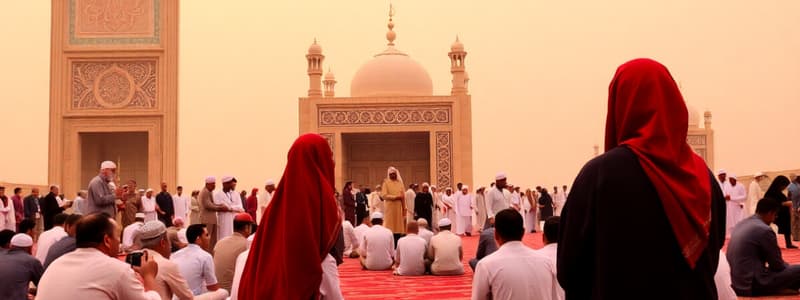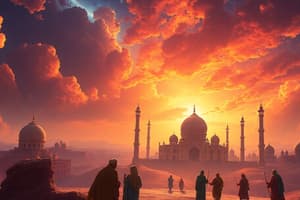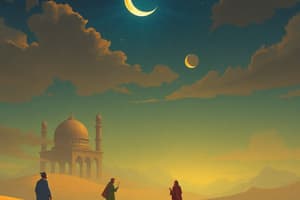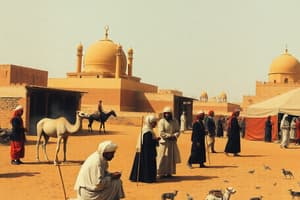Podcast
Questions and Answers
Which factor most significantly hindered Arab unity prior to the emergence of Islam?
Which factor most significantly hindered Arab unity prior to the emergence of Islam?
- Religious differences among the Arab people.
- Lack of a common language among the various tribes.
- Geographic barriers preventing communication.
- Frequent warfare and tribal loyalties. (correct)
Muhammad's initial success in gaining converts was not primarily among the wealthy merchant class of Mecca.
Muhammad's initial success in gaining converts was not primarily among the wealthy merchant class of Mecca.
True (A)
What is the significance of the Hegira in Islam?
What is the significance of the Hegira in Islam?
It marks Muhammad's flight from Mecca to Medina in 622, which is celebrated as year 1 in the Muslim calendar.
The sacred book of Islam, believed by Muslims to contain the words of Allah as revealed to Muhammad, is called the ______.
The sacred book of Islam, believed by Muslims to contain the words of Allah as revealed to Muhammad, is called the ______.
Match each of the Five Pillars of Islam with its description:
Match each of the Five Pillars of Islam with its description:
The Qur'an incorporates figures and stories from which religious texts?
The Qur'an incorporates figures and stories from which religious texts?
Islam affirms the doctrine of the Trinity and recognizes Jesus Christ as the Son of God, aligning with core Christian beliefs.
Islam affirms the doctrine of the Trinity and recognizes Jesus Christ as the Son of God, aligning with core Christian beliefs.
According to Islamic belief, what is the role of Muhammad in relation to other prophets?
According to Islamic belief, what is the role of Muhammad in relation to other prophets?
The Muslim place of worship, characterized by features such as a courtyard, minaret, and dome, is called a ______.
The Muslim place of worship, characterized by features such as a courtyard, minaret, and dome, is called a ______.
What was the primary cause of the split between Sunni and Shia Muslims?
What was the primary cause of the split between Sunni and Shia Muslims?
The Abbasid Caliphate marked a period of decreased cultural and intellectual growth within the Muslim empire compared to the Umayyad Caliphate.
The Abbasid Caliphate marked a period of decreased cultural and intellectual growth within the Muslim empire compared to the Umayyad Caliphate.
What significant contribution did Muslim scholars make to the preservation of ancient knowledge?
What significant contribution did Muslim scholars make to the preservation of ancient knowledge?
Omar Khayyam, a renowned Muslim figure, is best known for his contributions to both poetry and ______.
Omar Khayyam, a renowned Muslim figure, is best known for his contributions to both poetry and ______.
Which architectural feature is commonly used in mosques to call Muslims to prayer?
Which architectural feature is commonly used in mosques to call Muslims to prayer?
Muslim art is characterized by the frequent representation of human and animal figures, reflecting a reverence for living beings.
Muslim art is characterized by the frequent representation of human and animal figures, reflecting a reverence for living beings.
Flashcards
Arabian Peninsula
Arabian Peninsula
A large peninsula south of the Fertile Crescent, bounded by the Persian Gulf and the Red Sea. It's mostly barren desert.
Bedouins
Bedouins
Nomadic Arabs who roamed the desert in search of pastureland and water for their herds.
Muhammad
Muhammad
The founder of Islam, considered by Muslims to be the last and greatest prophet of Allah.
Allah
Allah
Signup and view all the flashcards
Islam
Islam
Signup and view all the flashcards
Kaaba
Kaaba
Signup and view all the flashcards
Hegira (Flight)
Hegira (Flight)
Signup and view all the flashcards
Qur'an
Qur'an
Signup and view all the flashcards
Five Pillars of Islam
Five Pillars of Islam
Signup and view all the flashcards
Shahadah
Shahadah
Signup and view all the flashcards
Salat
Salat
Signup and view all the flashcards
Zakat
Zakat
Signup and view all the flashcards
Sawm
Sawm
Signup and view all the flashcards
Hajj
Hajj
Signup and view all the flashcards
Caliphs
Caliphs
Signup and view all the flashcards
Study Notes
- Islam originated in Arabia, a peninsula south of the Fertile Crescent.
- Arabia is geographically large, about one-third the size of the United States.
- The Arabian environment is predominantly desert, which isolated the region until Islam's emergence.
- Arabs, like Hebrews, trace their lineage to Abraham through Ishmael.
- God promised to bless Ishmael and make him a great nation.
- Early Arabs lacked a unified government, leading to tribal loyalties and frequent warfare.
- Arabian society included nomadic Bedouins who roamed the desert for resources.
- Some Arabs settled in cities along trade routes and coastal areas, becoming trade centers.
The Founding of Islam
- Muhammad, born in Mecca around 570 AD, claimed to be the last prophet of Allah.
- Islam means "submission" to Allah, and Muslims are "submitters to Allah".
- Muhammad married Khadijah at age 25, gaining financial security.
- He meditated near Mecca, contemplating religion and the polytheism of his society.
- Muhammad received a vision from the angel Gabriel, as recorded in Muslim texts, instructing him to "Recite!" the words of Allah.
- Followers believed he was the messenger of God with a new revelation for mankind.
- Muhammad preached the oneness of God (Allah), initially gaining few converts.
- Early followers included family and close friends.
- Meccan leaders ridiculed Muhammad, viewing his teachings as a threat to their religious beliefs and commercial interests because of the Kaaba, a stone building that housed hundreds of idols.
- The Kaaba contained the Black Stone, revered and kissed by Arabs.
- Muslim tradition states that the angel Gabriel gifted the stone to Abraham.
- Meccan leaders persecuted Muhammad and his followers, as they rejected his teachings and feared their business would suffer.
The Flight to Medina
- In 622, Muhammad and his followers fled to Medina, known as the Hegira.
- The Hegira marks the first year of the Muslim calendar.
- In Medina, Muhammad's following grew rapidly, leading to his recognition as a spiritual, political, and military leader.
- Muhammad advanced Islam by force, slaughtering those who opposed him.
- In 630, he conquered Mecca, destroying the idols in the Kaaba (except the Black Stone) and establishing it as the center of Islamic worship.
- Mecca became Islam's "holy city".
The Teachings of Islam
- The Qur'an, meaning "recitations," is the sacred book of Islam.
- Muslims believe the angel Gabriel revealed the words of Allah to Muhammad.
- The Qur'an consists of 114 chapters (suras) and is the primary authority on Muslim belief and practice.
- The central doctrine of the Qur'an is the belief in one God, Allah.
- Muslims believe Allah sent over 100,000 prophets, including Muhammad as the last and greatest, with the Qur'an being Allah's final revelation.
- The Qur'an teaches moral principles, encouraging humility, duty, kindness, and condemning idolatry, murder, gambling, drinking, and adultery.
- Muslim men were allowed up to four wives, and temporary marriages.
- Muslims are taught to fear Allah's punishment in the afterlife.
- The Qur'an includes stories and characters from the Old and New Testaments, honoring Noah, Abraham, David, and Jesus as prophets of Allah.
- It emphasizes prayer, moral conduct, resurrection, judgment, heaven, and hell.
- Islam stresses the worship of one god and regards the Bible as a holy book.
- Muhammad's teachings distorted biblical truth, rejecting the Trinity and Jesus as the Son of God.
The Five Pillars
- Muslims believe that to enter paradise, they must perform certain religious duties.
- The Qur'an teaches Muslims to fear Allah's punishment if these practices are not observed.
- The Five Pillars of Islam are foundational religious duties:
- Shahadah: The thesis of Islam: "There is no God but Allah, and Muhammad is his prophet."
- Salat: Reciting prayers up to five times a day facing Mecca.
- Zakat: Giving alms (money) to the poor.
- Sawm: Fasting from sunrise to sunset during Ramadan.
- Hajj: Making a pilgrimage to Mecca if physically and financially able.
- Islam views Muhammad as the ultimate spokesman for divine truth, with the Qur'an being the final word from heaven.
- The Bible reserves this role for Jesus Christ, the Word of God.
- Islam honors Jesus as a prophet but rejects his role as God the Son.
- Islam praises Jesus as a prophet and accepts parts of the Bible but rejects the most important biblical claims about him.
- Islam denies Jesus came to save people from sin, denying the Resurrection.
- The Qur'an speaks of Allah as a God of justice, mercy, and forgiveness but lacks a basis for forgiveness without the sacrifice of Jesus.
- Murder of Muslims is forbidden in the Qur'an
Sunni vs Shia Islam
- Sunni Muslims believed that any worthy Muslim could be appointed to lead Islam, establishing the caliphate.
- The caliph was a political leader, judge, administrator, and general.
- Shia Muslims believed Muhammad intended Ali, his son-in-law, to be his successor with political and spiritual authority.
- Shia Muslims called their leader imam rather than caliph.
- Sunnis now use the term imam to refer to the leader of worship in a mosque, while Shiites claim an unbroken succession of imams from Ali.
- The caliphate was dissolved in 1924 by Turkish leader Mustafa Kemal, but Sunni Muslims look forward to its renewal.
The Spread of Islam
-
By 632, Muhammad united much of Arabia under Islam.
-
After Muhammad's death, his closest friends chose the first four caliphs ("successors") to lead Islam:
- Abu Bakr (632-34)
- Umar (634-44)
- Uthman (644-56)
- Ali (656-61)
-
These caliphs initiated military conquests, creating a vast Arab empire.
-
Arab warriors rapidly conquered Palestine, Syria, Egypt, Iraq, and Persia due to:
- Desire to escape poverty in Arabia through wealth gained from conquest.
- Weakened Byzantine and Persian Empires due to constant warfare.
- Islam united Arab tribes around a common cause (jihad), with the promise of paradise for those who died in battle.
Umayyad Caliphate (661-750)
- In 661, a Muslim general proclaimed himself caliph, moving the capital from Medina to Damascus and establishing the Umayyad dynasty.
- This ended the practice of selecting caliphs from Muhammad's close circle.
- The Umayyads expanded the empire into India, Constantinople, North Africa, and Spain.
- In 732, the Franks stopped the Muslim advance into Europe at the Battle of Tours.
Abbasid Caliphate (750-ca. 1000)
- Dissatisfaction with Umayyad rule led to Abbas overthrowing the Umayyad caliph in 750.
- Under the Abbasids, Arab supremacy declined as non-Arabs gained government positions and influence.
- The first defeat of Muslim forces was inflicted by the Nubians.
- The Nubians repulsed the Muslim invasion in 710 and remained free of Muslim control until 1272.
- The Abbasid dynasty marked the peak of the Muslim empire.
- Disputes over succession led to independent dynasties and a fractured Muslim world.
- The Seljuk Turks, accepting Islam, reunited much of the Arab empire and took control of Asia Minor.
- The aggressiveness of the Muslim empire and attacks on Christians prompted the Crusades.
- The Crusades weakened the Seljuks but did not remove Muslims from Palestine.
- In the thirteenth century, the Mongols ended the Seljuk Empire.
- The Ottoman Turks restored Turkish rule, creating an empire across North Africa, the Middle East, and southeastern Europe.
Muslim Culture Contributions
- The Arabs blended cultural influences from Persia, Byzantium, Egypt, and Syria with Islam, fostering a prosperous civilization.
- The capital moved to Baghdad under the Abbasids, demonstrating Persian influence.
- Muslim merchants traded with China, India, and East Africa, introducing new products and ideas like paper and mathematics.
- Muslim merchants opened up trade routes to the Middle East.
- The Abbasid caliphate marks the peak of the Muslim empire, controlling more territory than the ancient Romans.
- Baghdad became a leading commercial center rivaling Constantinople, and Islamic culture flourished.
- Crusaders encountered silk, muslin, linen, damask, carpets, leather, jewelry, silver, gold, knives, swords, dates, oranges, lemons, apricots, peaches, and melons in Muslim lands.
- Muslims translated manuscripts from other lands into Arabic, preserving writings from Aristotle, Plato, Galen, Hippocrates, Archimedes, Euclid, and Ptolemy.
- Muslim scholars built libraries to house these manuscripts and their Arabic translations.
Medicine
- Muslim doctors built upon the Greek writings of Galen and Hippocrates, developing new medical procedures.
- Al-Razi is known for his work with smallpox, and Ibn Sina (Avicenna) for his work with tuberculosis.
- Muslim doctors developed surgical skills: removing cancer and cataracts.
- Hospitals were built throughout the empire, with efforts to maintain cleanliness.
- Muslims had pharmacies supervised by government inspectors to ensure medicine purity.
Literature
- Muslims produced diverse literature from poetry to prose, with rich and colorful imagery.
- Omar Khayyam, a renowned poet and mathematician, is known for his Rubaiyat
- The Thousand and One Nights (The Arabian Nights) includes tales such as "Aladdin and His Wonderful Lamp" and "Ali Baba and the Forty Thieves".
Mathematics
- Muslims adopted Hindu numerals, decimal system, and the concept of zero, which they popularized.
- Enhanced knowledge of algebra (from India), as well as the geometry and trigonometry of the Greeks.
Art and Architecture
- Religion influenced Muslim art because Muhammad forbade representing men and animals.
- Muslim artists developed abstract designs of stems, leaves, and geometric figures.
- They excelled in calligraphy, adorning buildings with verses from the Qur'an in Arabic script.
- Manuscript illumination, with miniature paintings and decorative colors, was a honored art form.
- Muslim architecture, drawing from Persian and Byzantine styles, produced a unique style.
- Mosques: places of Muslim worship, feature courtyards, minarets, and domes.
- Courtyards have pools for ceremonial washing before prayer.
- Minarets (towers) are used by the muezzin to call the faithful to prayer.
- Domes typically cover the main portion of the mosque.
- Mosque walls are generally white and inscribed with quotations from the Qur'an, or decorated with tile and mosaic designs.
- Niches in mosque walls indicate the direction of Mecca, the direction a Muslim must turn when praying.
Studying That Suits You
Use AI to generate personalized quizzes and flashcards to suit your learning preferences.




